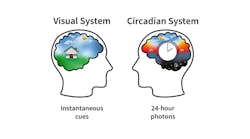In related news, Soitec has licensed its technology for hydride vapor-phase epitaxy (HVPE) technology to GT Advanced Technologies (GTAT). This will enable GTAT to manufacture HVPE systems for the deposition of GaN layers on sapphire substrates (see below for more details).
The Soitec-Sumitomo deal extends the strategic alliance between the two companies dating from December 2010, which aimed to leverage Sumitomo Electric’s expertise in materials technology and Soitec’s Smart Cut layer-transfer technology.
Most GaN-based LEDs begin life with the deposition of multilayer semiconductor structures on sapphire substrates. Cree uses silicon carbide for its LED production, while some manufacturers such as Toshiba are using silicon substrates. GaN substrates offer a significant advantage for the growth of GaN-based layers, namely the much lower lattice mismatch between the layers and the substrate. However, GaN bulk crystals are difficult to grow, and commercially available GaN substrates are generally small in size and very expensive.
The joint development program between Soitec and Sumitomo Electric has already demonstrated the capability to produce four- and six-inch engineered GaN substrates in a pilot production environment. High-quality, ultra-thin layers of GaN are transferred – using the Smart Cut process – onto new mechanical substrates.
The starting point is a large-diameter, free-standing GaN substrate, which is then bonded to a mechanical substrate. Smart Cut technology is used to remove the GaN substrate but leaving a thin GaN layer on top of the mechanical substrate. This is supplied to customers as the starting substrate for LED layer epitaxial growth. The separated GaN wafer can then be re-used. The companies say that the engineered wafers have exhibited high functionality at a low production cost.
Because Soitec’s material-transfer technology enables the reuse of GaN wafers several times, this achieves a substantial reduction in the cost of high-quality GaN materials to serve high-volume applications, according to Yoshiki Miura, general manager of the Compound Semiconductor Materials Division at Sumitomo Electric. “By combining the two innovative technologies – Soitec’s Smart Cut technology and our high-quality, large-diameter, free-standing GaN substrates – we are able to offer a high-value proposition to our LED customers,” said Miura.
Having proven the effectiveness of the technology-transfer process, Sumitomo Electric will now industrialize the product and invest in Smart Cut technology.
“This is the first licensing agreement of our Smart Cut technology to leverage a reusable, expensive base material to bring an economically viable process to this field,” said Frédéric Dupont, vice president of Soitec’s Specialty Electronics Business Unit.
Soitec’s Smart Cut technology has been developed in collaboration with CEA-Leti, a France-based research laboratory. It uses both implantation of light ions and wafer bonding to respectively define and transfer ultra-thin, single-crystal layers from one substrate to another. It works like an atomic scalpel, allowing active layers to be managed independently from the supporting mechanical substrate.
Soitec licenses HVPE technology
GT Advanced Technologies (NASDAQ: GTAT) and Soitec have signed a development agreement and a licensing agreement (please insert URL linking to press release) allowing GT to develop, manufacture and commercialize a high-volume, multi-wafer HVPE system to produce high-quality GaN epi layers.
The higher growth rates and improved material properties made possible by the HVPE system are expected to significantly reduce process costs while boosting device performance compared with the traditional MOCVD process, say the companies.
The HVPE system will enable the production of GaN layers on sapphire substrates. These so-called GaN template wafers can be used to grow LED epitaxial structures. The expected target date for the commercial availability of the HVPE system is the second half of 2014.




